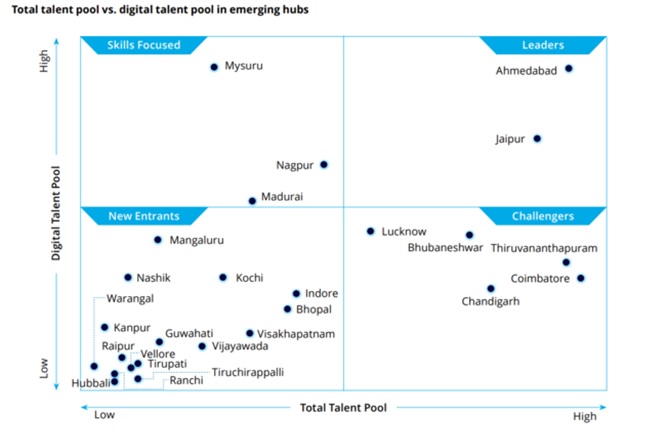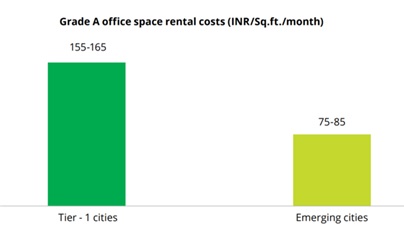De-Bengalurued: Why India’s tech industry is now rushing to 26 smaller cities
Relevance
- GS Paper 3: Indian Economy and issues relating to planning, mobilization, of resources, growth, development, and employment.
- GS Paper 1: Location of Industries.
- Tags: #indianeconomy #Deliotteindia #Nasscom #technologicalhub #tier2 #currentaffairs #upsc
Why in the News?
As per new report by Deloitte India and Nasscom, fuelled by infrastructure growth, skills, startup ecosystem and governmental initiatives, 26 tier 2 cities are emerging as next waves of technology hubs.
The Changing Face of India’s IT Industry
- The landscape of India’s IT industry is undergoing a transformation, moving away from its traditional technology hubs. Bengaluru, the pioneering tech hub, is now joined by six other prominent cities: Delhi NCR, Hyderabad, Chennai, Kolkata, Mumbai, and Pune.
- These seven cities have established themselves as mature and thriving technology hubs in India.
Challenges in Established Hubs
- However, the growth of these mature hubs is showing signs of tapering due to several factors.
- Remote work opportunities have emerged, allowing tech employees to work from anywhere. Infrastructure constraints and rising costs for talent and operations in these cities pose challenges for businesses. Consequently, companies are exploring alternative locations for expansion, as highlighted in a Nasscom-Deloitte report.
The Rise of Tier 2 Cities: The Next Wave of Technology Hubs
- Nasscom and Deloitte have identified a shift towards Tier 2 cities as the “next wave of technology hubs.” These emerging locations offer sustainable and scalable growth opportunities for the technology industry.
- Many tech enterprises have strategically set up operations in these cities to leverage their potential fully.
- Following locations can potentially establish themselves as emerging hubs of technological growth and innovation.
Cost-to-Value Advantage
- One of the key advantages of emerging cities is their favourable cost-to-value ratio. Companies can access high-quality talent at 25–30 percent lower costs than major tech centers, making these cities an attractive choice.
Why IT Companies are Flocking to Emerging Hubs
- Emerging hubs in Tier 2 cities address challenges related to talent availability and cost-effectiveness.
- They incentivize companies to adopt a multi-tier location strategy. These cities are witnessing rapid infrastructure development, diverse skill sets, a growing startup presence, and government initiatives like smart cities and tech parks, further propelling them toward Tier 1 status.
Talent Pools in Emerging Hubs
- A significant talent pool, with proficiency in the latest digital technologies, resides in these emerging hubs. Currently, 11–15 percent of tech talent is based in Tier 2 and Tier 3 cities, and this percentage is expected to rise as more people choose to work outside major metros.
- Smaller towns are producing a substantial portion of India’s graduates 60% of India’s graduates in engineering, arts, and science are in smaller towns, offering a competitive advantage to companies.
Infrastructure Development and Start-up Growth
- Infrastructure development is booming in Tier 2 cities, making them comparable to Tier 1 cities. Over 7,000 start-ups are operating from emerging hubs, with a 2.2× growth expected by 2025. Investors are increasingly comfortable investing in start-ups from Tier 2 cities, with 39 percent of tech start-ups established in 2022 originating from these locations.
- He report states that over 140 Global Capability Centres (GCCs) have already found a home in these locations, highlighting the growing interest of global enterprises in these locations.
Tech Talent Leaders
- Ahmedabad and Jaipur stand out as leaders in technology talent, with rich pools of core and digital skills. Other cities like Mysuru, Madurai, and Nagpur are also witnessing growth in emerging technologies due to state government policies and infrastructure development.
Real Estate Boom
- The demand for Grade A office spaces in emerging cities has surged, driven by technology companies establishing operations there.
- Rental costs have increased by 60–80 percent in the past five years due to this growing demand.
Emerging hubs offer a high quality of life, ranking well on various indices such as risk, regulatory environment, social factors, and living conditions. Government policies and investments are further enhancing these aspects, making these cities attractive to the workforce and promoting better employee retention.
Sources: The Economic Times, The Times of India.
Mains Questions
Examine the evolving landscape of India’s IT industry, with a particular focus on the shift towards Tier 2 cities as emerging technology hubs.
Discuss the key factors driving this transition and its implications for the IT sector, talent acquisition, and the overall socio-economic environment. (250 words)







